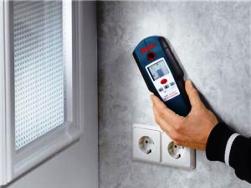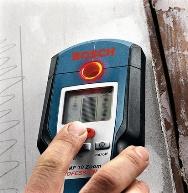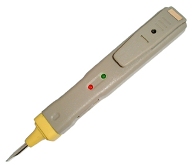Categories: Sharing experience, Interesting electrical news, Electrician at home
Number of views: 501121
Comments on the article: 18
Hidden Wiring Detectors - Woodpecker, MS-158M, MS-48, BOSCH DMF 10 zoom
 The article describes the principle of operation of several different devices for troubleshooting in wiring. This article will be useful both for beginner electricians, and for people who are just interested.
The article describes the principle of operation of several different devices for troubleshooting in wiring. This article will be useful both for beginner electricians, and for people who are just interested.
Almost every man at least once in his life, but hammered a nail into the wall. Someone in order to hang a beautiful, expensive painting, which was recently acquired at the exhibition. Someone just nailed a shelf for a flower. And surely every second thought flashed: "But is there any electric wire or fittings?" And it’s good if you have a drawing according to which electric wires were laid. And if there is no such picture? Then everyone acts at their own peril and risk.
But in order not to get into a mess and do business, there are special devices that relatively accurately indicate the presence of electrical wiring or fittings in this place.
 In this article we will consider the most popular and affordable devices for searching for hidden wiring.
In this article we will consider the most popular and affordable devices for searching for hidden wiring.
To understand how these same devices work, you need to know a little theory.
So, electric wires under voltage create an electric field around themselves. It is this electric field that these devices capture. Further, a special amplifier amplifies the signal and shows where our conductor is located.
Depending on the type and complexity of the device, a simple LED, dial gauge or digital display can be used as an indicator. Prices for these devices can be from $ 1 to several hundred or more, depending on the functionality and purpose.
There is another type of search appliance. hidden wiring. The principle of operation of these devices is the same as that of a metal detector. There is a coil that creates its own magnetic field. If a foreign metal object enters this field, the field changes. This is a crude theory, but I think you understand the principle of work.
Well, the third type of devices, these are hybrids of two main types. These devices have a built-in generator and amplifier. But these devices are already quite expensive and use them, as a rule, in laboratories. Although there are simple analogues for home use.
 Consider the most common and affordable devices for finding hidden wiring that are in our markets.
Consider the most common and affordable devices for finding hidden wiring that are in our markets.
One of the most popular appliances for hidden wiring fault detectionwhich many professional electricians use is "Woodpecker". Officially called "Flush warning device E121". This device is more than one year old. During this time, he established himself as one of the most reliable devices. Using the device is quite simple and easy. With the help of "Woodpecker" you can find wires under a layer of plaster up to 5-7 cm. This is perhaps one of the few affordable and high-quality devices that are manufactured with us. This device also responds well to electromagnetic radiation, which is created by almost all household appliances-TVs, m / in stoves, computers, etc.
Various Chinese-made devices from the MS series (metal sensor) are quite common with us. They gained special popularity due to their low cost.
Instrument for detecting metal parts and hidden wiring MS-158 M. Among professional electricians, it is not particularly popular, as it reacts to everything in a row - to nails, fittings, wires. In order to use it correctly, you need to get used to it. After some time, with the constant operation of this device, it is already possible to distinguish the reinforcement from the nails and wires by the signal strength.
MS-58 M. An earlier model of the MS-158.It differs from the MS-158 only in case design. At 158 it is more modern and practical.
Due to their low price, these devices are purchased mainly by novice electricians and home masters.
 MS-48, MS-18 and other indicators of this class. They are made in the form of ordinary indicators. Use these devices very, very carefully. Even knowing the principle of operation of this device, but not having the appropriate experience in using these indicators, every second has a chance to get acquainted with electricity closer than we would like.
MS-48, MS-18 and other indicators of this class. They are made in the form of ordinary indicators. Use these devices very, very carefully. Even knowing the principle of operation of this device, but not having the appropriate experience in using these indicators, every second has a chance to get acquainted with electricity closer than we would like.
If the wall in which the wire is laid is slightly damp, or the humidity of the room is above normal, the indicator will constantly light up, wherever you bring this “miracle device”. Although, in fairness, I want to note that with appropriate preparation and "dexterity", the device can relatively accurately + -15-20 cm, determine the location of the electric wire. And with a little training, you can even find a place where a wire break occurred.
For a more professional approach to the problem of troubleshooting, there are better instruments. The principle of operation is based on the fact that a generator of a certain frequency is connected to one of the ends. A receiver tuned to the same frequency is carried along the cable. In the place where the tonality has changed, there is a place for cable damage. But these devices are relatively expensive and are used, as a rule, in mobile electric laboratories. A similar, but more compact, device is used by telephone operators to search for cable damage.
 There are many more foreign pretty high-quality devices for detecting wiring in the wall. But these devices are quite expensive and not everyone can afford them. And, frankly, their performance wants to leave the best.
There are many more foreign pretty high-quality devices for detecting wiring in the wall. But these devices are quite expensive and not everyone can afford them. And, frankly, their performance wants to leave the best.
An example of such a device is BOSCH DMF 10 zoom. The device is good for everyone. Beautiful, compact, easy to use, but from its Chinese counterparts it differs only in build quality and performance. The principle of operation is approximately the same.
In any case, appropriate skills and knowledge are needed to work with these devices. With appropriate proper handling, any of the above devices, even the simplest and cheapest, will greatly facilitate troubleshooting wiring.
Trust professionals, and you will be happy. Good luck to you!
Sergey Seromashenko
See also at bgv.electricianexp.com
:
